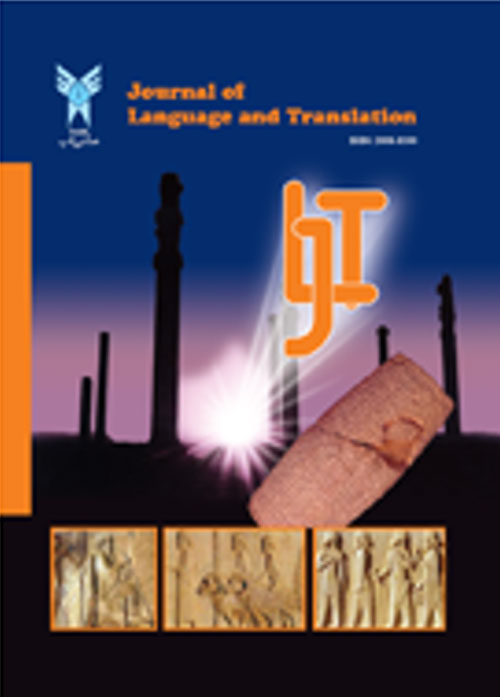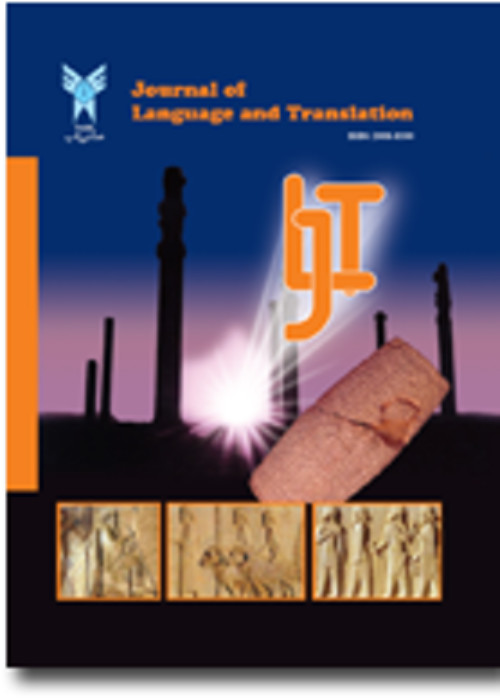فهرست مطالب

Journal of Language and Translation
Volume:2 Issue: 2, Autumn 2012
- تاریخ انتشار: 1391/08/01
- تعداد عناوین: 3
-
Pages 1-6This research study investigates the impact of three sorts of simplification of reading comprehension passages through translating, paraphrasing and elaborating new words and expressions on the Iranian language teaching freshmen's reading comprehension ability. In phase one six English reading pas- sages in one of three types- (a) translated, (b) paraphrased, (c) elaborated words and expressions- were offered to 90 male and female subjects categorized in three groups for three consecutive ses- sions. The ANOVA statistical findings unraveled that paraphrasing had the significant meaningful impact on the subjects' reading comprehension ability. In phase two 180 students were divided into two sexes (i.e., males and females) in six thirty-subject groups to be exposed to the three aforemen- tioned reading comprehension approaches for six sessions. Comprehension was assessed by reading comprehension questions (10 items) and a twenty-item M/C test for each of the three abovemen- tioned passage types. The test data were analyzed through a 2X3 ANOVA Factorial design along with post hoc analyses. The results revealed that the female subjects benefited from paraphrasing more than the males while the males outperformed their counterparts in the realm of translated pas- sages. Elaboration helped the both sexes more or less to the same degree. Accordingly, the educa- tional materials developers and designers are considerably recommended to take this issue into con- sideration which may count as the ultimate objective of EFL reading instruction.Keywords: ANOVA, Factorial Design, M, C test, Paraphrasing, Post hoc analyses, Translation
-
Pages 7-18This study aimed to discover the insight of error correction by implementing two correction systems on three Iranian university students. The three students were invited to write four in-class essays throughout the semester, in which their verb errors and individual-selected errors were corrected using the Code Correction System and the Individual Correction System. At the end of the study, the students’ change of verb errors and individual errors from the first to the last in-class essays were calculated to examine the effectiveness of the two correction systems in this study. Moreover, to uncover the students’ perceptions and opinions toward the two correction systems, three researcherstudent conferences were conducted each time after the correction. The findings of this study suggested that (1) Conferences are important for students to clarify confusing ideas and enhance their interaction with the teacher and their errors. It is recommended to be used in error correction to make the correction procedure a two-direction communication; (2) Learner-centered correction in which the control rests on learners may contribute to learners’ autonomy of learning and intrinsic motivation, and may further result in the effectiveness of error correction; (3) While correcting students’ errors, teachers may need to pay more attention to less-advanced students, as they may need more help and may benefit much from the correction; (4) The better way to solve Iranian university students’ problem in using English tenses may be to expose them to more authentic English, but not in over-simplified rules; and (5) Teachers should avoid putting answers directly on students’ written errors, but adopt more implicit error identification techniques for students to reflect on their own errors.Keywords: Code Correction, error correction, Error Identification Techniques
-
Pages 19-24This article describes how a group of Iranian upper-intermediate EFL learners were guided through the practice of writing their first academic essays in English. The method applied the principle of scaffolding to the essay writing process by providing flexible support for the learners during the writ- ing their first essays. Scaffolding included a number of aspects, each of which is explained in this paper. The researcher discusses that the approach he adopted promotes learners autonomy by focus- ing on an authentic task, making the requirements of the task explicit, and providing flexible support for the students as they approach the target performance.Keywords: Academic essay, Authentic task, scaffolding


